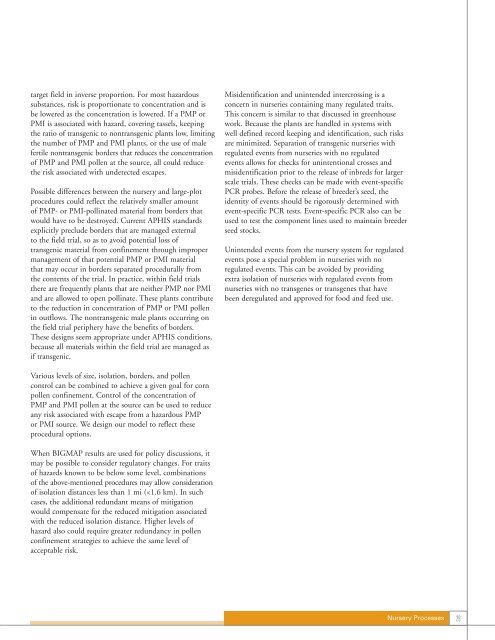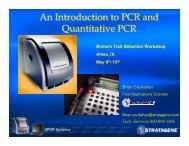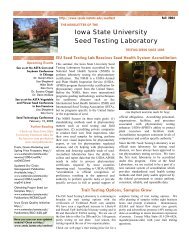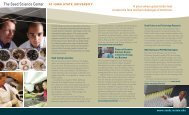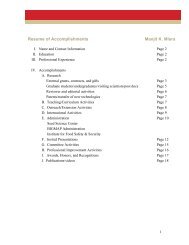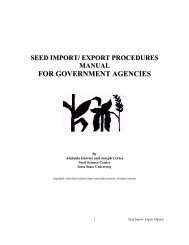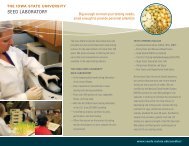CONFINED NURSERIESThe procedures that have been approved by APHIS <strong>for</strong>corn nurseries are the same as <strong>for</strong> all PMP production:• At any time during the field test when PMP plants areallowed to shed pollen, ensure that no other receptivecorn plants are grown within a radius of 1.0 mi(1.6 km) of the transgenic plants.• Where pollination of PMP plants is controlled, ensurethat transgenic corn is planted not less than 28 daysbe<strong>for</strong>e or 28 days after the planting dates of any othercorn that is growing within a zone extending from0.5 to 1.0 mi (0.8 to 1.6 km) of the transgenic plantsto ensure that there is no overlap in anthesis.• There are no other restrictions on corn that is grown atmore than 1 mi (>1.6 km) from the transgenic plants.These standards have been established using in<strong>for</strong>mationabout pollen number (Pohl, 1937; Ogden et al., 1974;Paterniani and Stort, 1974; Poehlman and Sleper, 1995;Coe et al., 1998), pollen size (Pohl, 1937; Funkhouserand Evitt, 1959), duration of pollen shed (Lauer, 1998),viability (Shoper et al. 1987; Luna et al., 2001), anddispersion. Because pollen size and mass have not changedsignificantly, distribution measurements done in the pastremain valid (Jones and Brooks, 1950; Wych, 1998;Di-Giovanni et al., 1995; Burris, 2001). Wind speedhas been verified as a factor (Raynor et al., 1972; Burris,2001). Theoretical work has been done on the maximumdistance of pollen flow (Raynor et al., 1972; Ireland et al.,2001; Luna et al., 2001). New in<strong>for</strong>mation and theoryare contributing to the validation of dispersion times(Fonseca, 2002). Recent research has been oriented onthe impact of transgenic pollen inflow in corn seedproduction (Ingram, 2000; Burris, 2001; Eastham andSweet, 2002).For nurseries, it is possible to envision additionalmeans beyond pollination control and isolation by whichoutcrossing and its consequential risk can be mitigated:• In hand-pollinated nurseries, internal non-PMPor -PMI border plantings may act as barriers anddiminish the concentration of PMP and PMI pollenemanating from the source.• Reduction in the number of transgenic PMP plantswithin the trial to diminish the concentration of PMPand PMI pollen at the source.• Reduction in the proportion of transgenic plants in thenursery to diminish the concentration of PMP andPMI pollen at the source.• Active daily surveillance by trained personnel of fieldduring flowering to ensure pollen control.• More comprehensive standard operating proceduresto minimize potential loss of pollen, plants, or seedsfrom confinement than could be implemented <strong>for</strong>larger fields.Such nursery procedures reflect the scientifically documentedinfluence of the size of the source (Ministère de l’Agricultureet de la Pêche, 2002) and borders (Jones and Brooks, 1950)on the rate of outcrossing in corn. Possible differencesbetween the nursery and large plot procedures andstandards reflect the influence size of the source as well asdifferences in borders, pollen control, and the concentrationof PMP or PMI pollen at the source.Multiple mechanisms contribute to the efficacy of borderrows within the field in reducing concentration of pollinationsin a receptor field. Border rows at the periphery of thetrial work partially because pollen grains on receptive silksare competitive and deteriorate with time after they arereleased. Pollen that has traveled further is older and lesslikely to compete well with younger pollen grains fromthe border and is less likely to effectively pollinate a kernelin a receptor field. The border also acts as a partial physicalbarrier. These effects reduce the level of PMP and PMIgrains in any corn that might be pollinated from insidethe perimeter border. Border rows also diminish theconcentration of PMP and PMI pollen at the source.Reductions in this concentration reduce the probability ofescape but may not prevent escape. Reduction can reducethe risk associated with escape of a hazardous PMP orPMI. If one assumes a fixed amount of PMP or PMIpollen escapes the field, increasing the amount ofnontransgenic pollen of similar viability moving with itwill reduce the concentration of PMP or PMI in the
target field in inverse proportion. For most hazardoussubstances, risk is proportionate to concentration and isbe lowered as the concentration is lowered. If a PMP orPMI is associated with hazard, covering tassels, keepingthe ratio of transgenic to nontransgenic plants low, limitingthe number of PMP and PMI plants, or the use of malefertile nontransgenic borders that reduces the concentrationof PMP and PMI pollen at the source, all could reducethe risk associated with undetected escapes.Possible differences between the nursery and large-plotprocedures could reflect the relatively smaller amountof PMP- or PMI-pollinated material from borders thatwould have to be destroyed. Current APHIS standardsexplicitly preclude borders that are managed externalto the field trial, so as to avoid potential loss oftransgenic material from confinement through impropermanagement of that potential PMP or PMI materialthat may occur in borders separated procedurally fromthe contents of the trial. In practice, within field trialsthere are frequently plants that are neither PMP nor PMIand are allowed to open pollinate. These plants contributeto the reduction in concentration of PMP or PMI pollenin outflows. The nontransgenic male plants occurring onthe field trial periphery have the benefits of borders.These designs seem appropriate under APHIS conditions,because all materials within the field trial are managed asif transgenic.Misidentification and unintended intercrossing is aconcern in nurseries containing many regulated traits.This concern is similar to that discussed in greenhousework. Because the plants are handled in systems withwell defined record keeping and identification, such risksare minimized. Separation of transgenic nurseries withregulated events from nurseries with no regulatedevents allows <strong>for</strong> checks <strong>for</strong> unintentional crosses andmisidentification prior to the release of inbreds <strong>for</strong> largerscale trials. These checks can be made with event-specificPCR probes. Be<strong>for</strong>e the release of breeder’s seed, theidentity of events should be rigorously determined withevent-specific PCR tests. Event-specific PCR also can beused to test the component lines used to maintain breederseed stocks.Unintended events from the nursery system <strong>for</strong> regulatedevents pose a special problem in nurseries with noregulated events. This can be avoided by providingextra isolation of nurseries with regulated events fromnurseries with no transgenes or transgenes that havebeen deregulated and approved <strong>for</strong> food and feed use.Various levels of size, isolation, borders, and pollencontrol can be combined to achieve a given goal <strong>for</strong> cornpollen confinement. Control of the concentration ofPMP and PMI pollen at the source can be used to reduceany risk associated with escape from a hazardous PMPor PMI source. We design our model to reflect theseprocedural options.When BIGMAP results are used <strong>for</strong> policy discussions, itmay be possible to consider regulatory changes. For traitsof hazards known to be below some level, combinationsof the above-mentioned procedures may allow considerationof isolation distances less than 1 mi (


